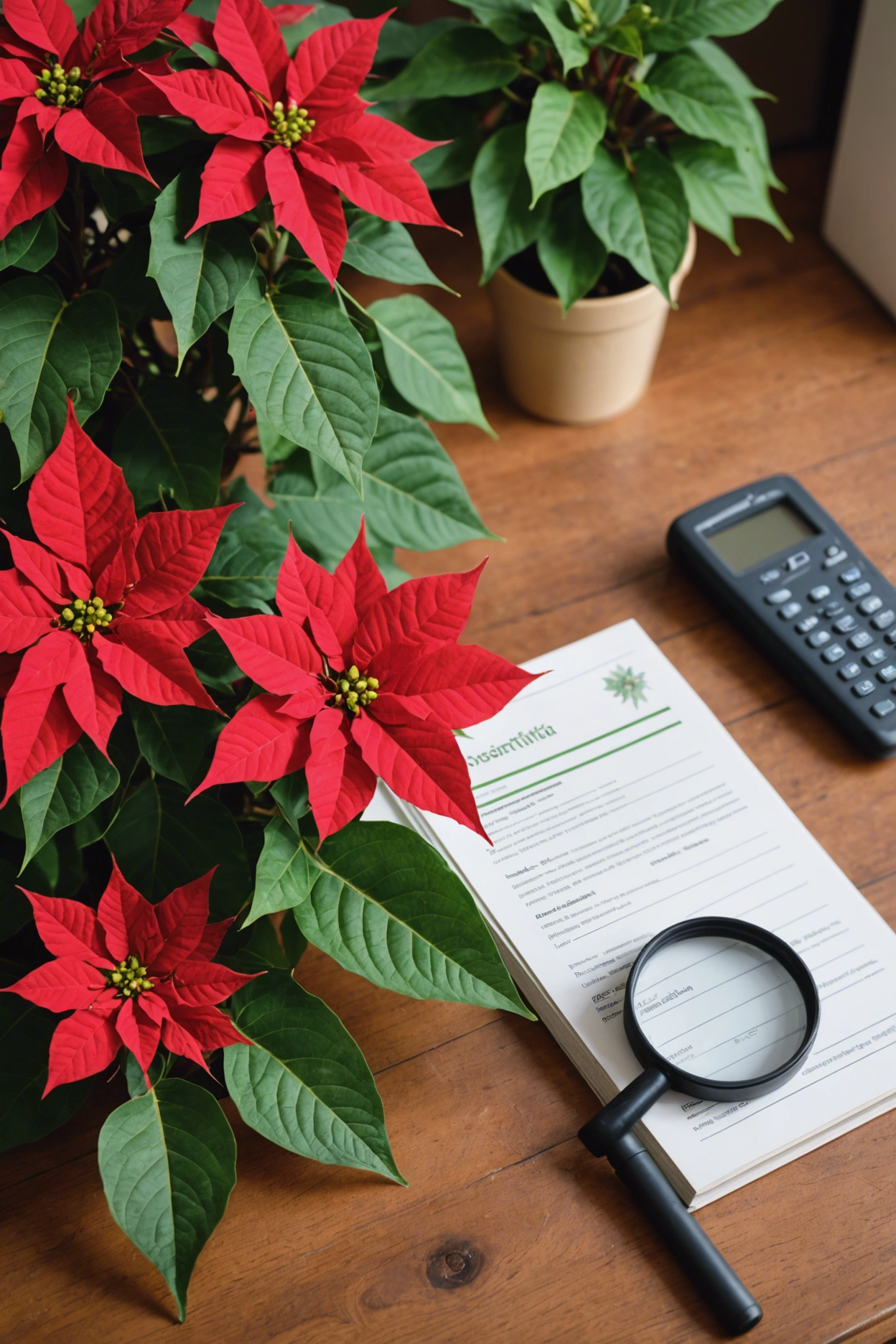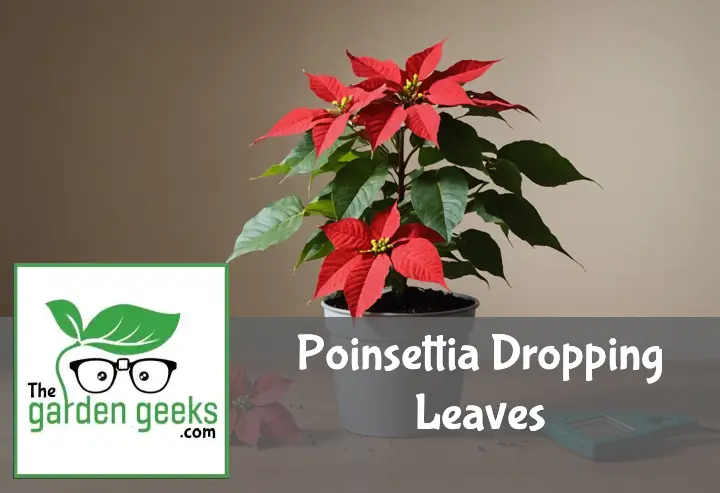Did you know that the poinsettia, a vibrant plant often associated with holiday cheer, is native to Mexico and can grow up to 16 feet tall in its natural habitat? However, when we bring them into our homes, they sometimes struggle to adapt. If you’ve noticed your Poinsettia Dropping Leaves, there’s no need to panic just yet.
It’s not uncommon for poinsettias to shed their leaves due to changes in environment or care routine. However, understanding the cause of this leaf drop is crucial for reviving your festive plant and preventing future foliage loss.
Keep reading about Poinsettia Dropping Leaves and discover how you can nurse your poinsettia back to health and keep it thriving well beyond the holiday season.
Quick Answer
- Poinsettia dropping leaves is often due to environmental stress like incorrect temperature, overwatering or underwatering, and pest infestations.
- To assess your poinsettia’s health, check for signs of water issues (yellow leaves for overwatering, wilting for underwatering) and pests or diseases.
- Revive your poinsettia by adjusting its environment, watering correctly, and treating any identified pests or diseases.
- Prevent leaf drop in the future by providing optimal light and temperature conditions, and using proper watering and fertilization techniques.

Why is My Poinsettia Dropping Leaves?
Common Causes of Leaf Drop
Have you ever wondered why your poinsettia starts acting like it’s throwing a tantrum by dropping its leaves? Well, there are a few usual suspects behind this. First off, overwatering poinsettias is like giving them too much love – they can’t handle it. Imagine wearing wet socks all day; that’s how the poinsettia feels with soggy roots.
Then there’s the unseen enemy – disease in poinsettias. These plants can catch nasty bugs faster than a kid in daycare. Root rot and fungal infections in plants are like silent assassins, sneaking up without much warning.
And don’t forget about the tiny critters! An insect infestation can turn your poinsettia’s life into a horror movie scene quicker than you can say “bug spray.” These little guys suck the life out of leaves, leading to a sad, leafless plant.
Environmental Stress Factors
Now, let’s talk about how being picky with their environment can lead to a poinsettia leaf drop. It’s all about finding that sweet spot. Too hot or too cold, and your plant will start dropping leaves faster than trees in autumn. This is what we call temperature stress on plants.
Next up is lighting – think of your poinsettia as needing its spotlight just right. Not enough light and it’ll lose color and leaves, but too much direct sunlight? That’s a recipe for a sunburned plant! Proper light exposure for poinsettias is key.
Lastly, these divas have specific humidity needs. Too dry and they’ll start shedding leaves like crazy. It’s all about creating that perfect jungle vibe indoors for them without turning your home into an actual rainforest. Remember, good indoor plant care includes keeping an eye on these poinsettia environmental needs to prevent those dramatic leaf drops.
How to Assess the Health of Your Poinsettia
Regular poinsettia health checks are crucial. Look out for signs like wilting leaves or discoloration, which scream “Help me!” Also, keep an eye out for uninvited guests like pests.
Signs of Overwatering or Underwatering
When your poinsettia starts acting up, it’s like a mystery you’ve got to solve. Is it getting too much water or not enough? Here’s how to crack the case. If the leaves look sad and soggy, you’re probably loving it a bit too much with water. That’s overwatering symptoms in poinsettias for you. On the flip side, if the leaves are dry and crispy, like a fall leaf crunching underfoot, that’s a cry for more water – classic underwatering signs in plants.
But wait, there’s more! The soil can also spill the beans on your watering habits. Too wet? You guessed it; you’re overdoing it. Bone dry? Time to get pouring. Remember, finding that Goldilocks zone of “just right” when watering poinsettias correctly is key.
Identifying Pest Infestations and Diseases
Now onto something a bit icky but super important – bugs and ickies making your poinsettia their home sweet home. First off, if you see tiny insects or weird webbing on your plant, sound the alarm! Those could be spider mites or whiteflies – notorious pests affecting poinsettias.
But wait, there’s more trouble that can hit your beloved plant – diseases! If your poinsettia starts showing spots or looks like it’s just not its vibrant self, it might have caught something nasty. These are tell-tale signs of fungal infections or other scary-sounding diseases.
Catching these issues early by doing regular poinsettia health checks can save your plant from turning into a holiday horror story. So keep those peepers peeled for any strange changes in your plant’s appearance!



Reviving a Poinsettia with Dropping Leaves


If your poinsettia is starting to look more like a stick than a lush, vibrant plant, don’t throw in the towel just yet! Poinsettias dropping leaves can be a cry for help, and with the right care, you can bring them back to their festive glory. Let’s dive into the steps to revive your poinsettia and keep it happy.
-
Check the soil moisture. Stick your finger about an inch into the soil. If it’s dry, it’s time to water; if it’s soggy, you’ve overdone it. Poinsettias prefer soil that is consistently moist but not waterlogged. Give your plant a good drink if needed, but make sure any excess water can drain away.
-
Ensure proper lighting. These plants love bright, indirect sunlight. If your poinsettia has been sitting in a dark corner or right under harsh light, move it to a spot where it can enjoy the perfect balance of sunshine without getting scorched.
-
Keep the temperature just right. Poinsettias are picky about temperature too! They thrive in conditions between 65-70°F (18-21°C) during the day and slightly cooler at night. Avoid placing your plant near drafts or heat sources which can cause stress and leaf drop.
-
Boost humidity around your plant. Indoor heating can dry out the air in our homes, leaving tropical plants like poinsettias thirsting for moisture in the air around them. You can increase humidity by placing a humidifier nearby or setting your plant on a tray filled with pebbles and water (just make sure the pot isn’t sitting directly in water).
-
Feed it right. If your poinsettia is losing leaves during its growing season (spring and summer), it might be hungry! Feed it every two weeks with a balanced liquid fertilizer diluted to half strength until early fall.
-
Prune wisely to encourage new growth and give your poinsettia shape and structure. After all danger of frost has passed and when you notice new growth beginning, trim back old stems to about 4-6 inches from the soil level.
-
Watch out for pests such as whiteflies or spider mites which could be stressing your plant and causing leaf drop. Inspect under leaves and at stem joints for signs of these critters and treat accordingly with insecticidal soap or neem oil.
-
Finally, practice patience! Reviving a stressed poinsettia won’t happen overnight but stick with these steps, adjusting as needed based on how your plant responds.
Preventative Measures for Healthy Poinsettias
Taking care of poinsettias isn’t rocket science, but a few smart moves can keep them happy and prevent those dreaded leaf drops.
Optimal Lighting and Temperature Conditions
Poinsettias are like that friend who loves the spotlight but also needs their beauty sleep. They thrive in bright, indirect light for about 6 hours a day. Too much direct sunlight? Bad news – it’s like sunburn for them. And at night, they prefer it cool, around 60-70 degrees Fahrenheit. It’s all about balance.
Now, let’s talk temperature. These plants dislike the cold as much as ice cream on a winter day. Keep them away from drafty windows and doors. They’re not fans of sudden temperature changes either. Think of them as Goldilocks – the conditions need to be just right.
Proper Watering and Fertilization Techniques
Watering poinsettias is kind of like feeding a baby – too much or too little, and you’ll hear about it. Wait until the top inch of soil feels dry, then give it a drink with room-temperature water. Let any excess water drain away because no one likes wet feet, especially not poinsettias.
Fertilizer is like vitamins for your plant; it doesn’t need a lot but gets cranky without it. After the blooming season, start with a balanced fertilizer every month to keep it strong. Remember, over-fertilizing is like overeating – it can cause more harm than good.
By sticking to these poinsettia care tips, you’re not just avoiding leaf drop; you’re setting the stage for vibrant growth year after year. So keep an eye on lighting, temperature, watering, and fertilization, and your poinsettia will be more than just a holiday guest – it’ll be part of the family.
To Wrap Up
So, you’ve got a Poinsettia Dropping Leaves issue. It’s not the end of the world, folks! Remember, these festive plants are tropical natives and they can be a bit finicky when it comes to changes in temperature, light, and watering.
What you need to do is simple. Keep your poinsettia cozy (not too hot or cold), give it some good ol’ sunlight but not too much, okay? And water it just right – not too little, not too much.
Finally, don’t forget to check out this link for more detailed info. Let’s keep those poinsettias happy and leafy!


FAQs about ‘Poinsettia Dropping Leaves? (How to Save it)’.
What is the optimal temperature for poinsettias?
Poinsettias prefer temperatures between 60 and 70 degrees Fahrenheit. They can tolerate a range from 50 to 80 degrees, but extremes can cause leaf drop.
How often should I water my poinsettia?
Water your poinsettia when the surface of the soil feels dry to the touch. Overwatering can lead to root rot, which causes leaves to drop.
Can over-fertilization cause leaf drop in poinsettias?
Yes, excessive fertilization can lead to salt buildup in the soil, causing leaf burn and eventual leaf drop. It’s best to fertilize sparingly and only during active growth periods.
Is it normal for a poinsettia to lose some leaves after Christmas?
Yes, it’s normal. Poinsettias are short-day plants that naturally lose their leaves after blooming. Adjust care routines accordingly during this period.
How do I know if my poinsettia has a disease or pest infestation?
Signs include discolored or spotted leaves, stunted growth, or an unusual number of fallen leaves. If you suspect a pest infestation or disease, consult with a plant expert or local nursery.
Are there any non-chemical ways to treat diseases and pests in poinsettias?
Yes, methods include using natural predators like ladybugs for aphids or neem oil as a natural insecticide/fungicide. Always test any treatment on a small part of the plant first.
Can repotting help save a poinsettia with dropping leaves?
Potentially yes. If root rot from overwatering is suspected, repotting into fresh soil can help revive your plant. However, ensure not to damage roots during this process.
How can I prevent my poinsettia from dropping leaves next year?
Maintain optimal light, temperature, and watering conditions. Also, keep an eye out for signs of pests or diseases. A little preventative care goes a long way!


